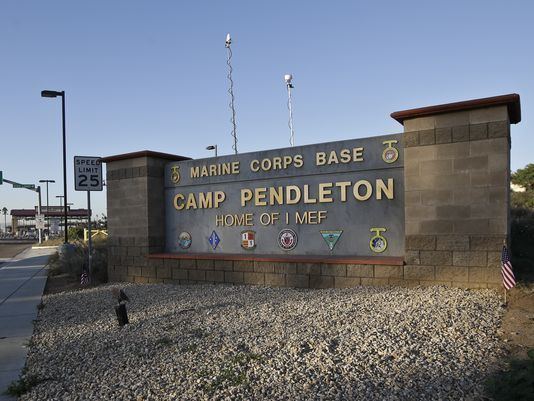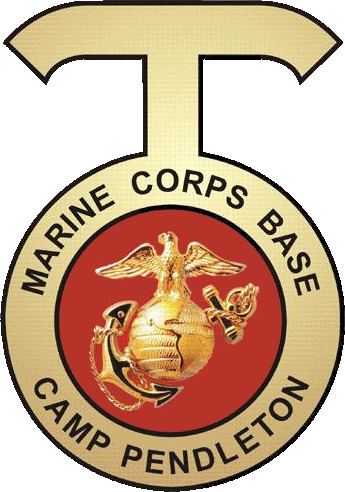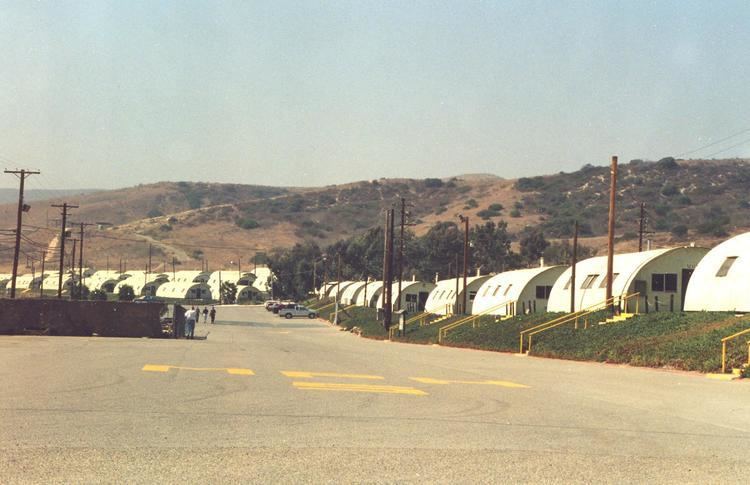Type Military base Currentcommander BGen Kevin J. Killea | Built March 1942 (1942-03) | |
 | ||
In use September 25, 1942 – present Controlled by | ||
Marine corps base camp pendleton
Marine Corps Base Camp Pendleton is the major West Coast base of the United States Marine Corps. It is located on the Southern California coast, in San Diego County, and bordered by Oceanside to the south, Cleveland National Forest, Orange and Riverside counties to the north, and Fallbrook to the east.
Contents
- Marine corps base camp pendleton
- Marine corps base camp pendleton new naval hospital project
- Prior to World War II
- World War II
- Korean War through the 1950s
- 21st century
- Unit locations by area
- Ecology
- References

The base was established in 1942 to train U.S. Marines for service in World War II. By October 1944, Camp Pendleton was declared a "permanent installation" and by 1946, it became the home of the 1st Marine Division. It was named after Major General Joseph Henry Pendleton (1860–1942), who had long advocated setting up a training base for the Marine Corps on the west coast. Today it is the home to myriad Operating Force units including the I Marine Expeditionary Force and various training commands.

Marine corps base camp pendleton new naval hospital project
Prior to World War II

In 1769, a Spanish expedition led by Captain Gaspar de Portolá explored northward from Loreto, Baja California Sur, seeking to reach Monterey Bay, something never before done overland by Europeans. On July 20 of that year, the expedition arrived in the area now known as Camp Pendleton, and as it was the holy day of St. Margaret, they christened the land in the name of Santa Margarita. The expedition went on to establish military outposts and Franciscan missions at San Diego and Monterey.

During the next 30 years, 21 missions were established, the most productive one being Mission San Luis Rey, just south of the present-day Camp Pendleton. At that time, San Luis Rey Mission had control over the Santa Margarita area.

After 1821, following the Mexican War of Independence from Spain, some of the former members of the Portolà expedition who had stayed on (mostly garrison soldiers) were awarded large land grants (ranchos) by Mexican governors. The retired soldiers were joined as rancheros by prominent businessmen, officials and military leaders. They and their children, the Californios, became the landed gentry of Alta California.
In 1841, two brothers, Pio Pico and Andrés Pico, became the first private owners of Rancho Santa Margarita. More land was later added to the grant, giving it the name of Rancho Santa Margarita y Las Flores, which stayed with the ranch until the Marine Corps acquired it in 1942. The design of the ranch's cattle brand is seen in the base's logo today.
In 1863, an Englishman named John (Don Juan) Forster (Pio Pico's brother-in-law) paid off Pico's gambling debts in return for the deed to the ranch. During his tenure as owner of the ranch, he expanded the ranch house, which was first built in 1827, and developed the rancho into a thriving cattle industry.
Forster's heirs, however, were forced to sell the ranch in 1882 because of a string of bad luck, which included a series of droughts and a fence law that forced Forster to construct fencing around the extensive rancho lands. It was purchased by wealthy cattleman James Clair Flood and managed by Irishman Richard O'Neill, who was eventually rewarded for his faithful service with half ownership. Under the guidance of O'Neill's son, Jerome, the ranch began to net a profit of nearly half a million dollars annually, and the house was modernized and furnished to its present form.
World War II
In the early 1940s, both the Army and the Marine Corps were looking for land for a large training base. The Army lost interest in the project, but in February 1942 it was announced that the 122,798 acres (497 km2) of Rancho Santa Margarita y Los Flores was about to be transformed into the largest Marine Corps base in the country. It was named for Major General Joseph Henry Pendleton who had long advocated the establishment of a West Coast training base. Construction began in April but the base was considered a temporary facility so it was built to minimum standards of wood frame construction. After five months of furious building activity, the 9th Marine Regiment, under then Colonel Lemuel C. Shepherd Jr., marched from Camp Elliott in San Diego to Camp Pendleton to be the first troops to occupy the new base. On September 25, 1942, President Franklin D. Roosevelt officially dedicated the base. Wartime training facilities at the base included landing craft school, amphibious tractor school, beach battalion school, amphibious communications school, and a medical field service school at the naval hospital at Santa Margarita Ranch. This facility was also used as a base for discharging soldiers returning from Europe and Asia after World War II ended in 1945, and for the processing of their discharge documents for same.
Korean War through the 1950s
During the Korean War, $20 million helped expand and upgrade existing facilities, including the construction of Camp Horno. When Camp Pendleton trained the country's fighting force for the Korean and Vietnam Wars, approximately 200,000 Marines passed through the base on their way to the Far East.
Beginning in 1954, Camp Pendleton has hosted a variation of Basic Training familiarization for teenagers age 14 to 17. This training, called "Devil Pups", promotes physical fitness, instills discipline and promotes love of country and the Marine Corps.
The camp's stables display a plaque and statue commemorating a horse, Sergeant Reckless, which served with the Marine Corps in Korea.
In 1975 Camp Pendleton was the first military base in the U.S. to provide accommodations for Vietnamese evacuees in Operation New Arrivals; over 50,000 refugees came to the base in the largest humanitarian airlift in history.
Camp Pendleton has continued to grow through renovations, replacing its original tent camps with more than 2,626 buildings and over 500 miles of roads.
Efforts today continue to preserve the heritage of Camp Pendleton's founders and the Marine Corps' history. The original ranch house has been declared a National Historic Site as well as the Las Flores Adobe.
21st century
The base's diverse geography, spanning over 125,000 acres (506 km2), plays host to year-round training for Marines in addition to all other branches of the U.S. military. Amphibious and sea-to-shore training takes place at several key points along the base's 17 miles (27 km) of coastline. The main base is in the Mainside Complex, at the southeastern end of the base, and the remote northern interior is an impact area. Daytime population is around 100,000. Recruits from nearby Marine Corps Recruit Depot, San Diego spend a month on Pendleton's Edson Range receiving field training, and after graduating from boot camp return to the base's School of Infantry for further training.
Camp Pendleton remains the last major undeveloped portion of the California coastline south of Santa Barbara, save for a few relatively small state parks. In 2015 the site was proposed for a large civilian airport
Since August 2004, Camp Pendleton has been one of five locations in the Department of Defense to operate the Standard Terminal Automation Replacement System (STARS) air radar. The STARS radar allows the facility to simulate air traffic for training purposes.
Camp Pendleton's five-man color guard has participated in many sporting events in San Diego and at the 1996 Republican National Convention, accompanying national anthem performers. Among the more famous performers who were accompanied by the Camp Pendleton color guard have been Frankie Laine, Herb Alpert, Wilson Phillips, Jewel, Trisha Yearwood and the Dixie Chicks, all of whom had performed the National Anthem at either a World Series game, Super Bowl, or, in Wilson Phillips' case, a Major League Baseball All-Star Game that was played at what is now Qualcomm Stadium.
Unit locations (by area)
Ecology
Camp Pendleton was built on a wide swath of coastal land that once supported an estuary at the mouth of the Santa Margarita River and extensive salt marsh habitat. Outlying land within the base is made up of floodplain, oak woodlands, coastal dunes and bluffs, coastal sage scrub, chaparral, and several types of wetlands, including ephemeral wetlands such as vernal pools. Wildfire is not uncommon. Research in ecology takes place in undeveloped areas of base, which contain examples of rare and endangered California habitat types. The Department of Defense has issued management plans for various ecosystems on this territory.
Land within the base still includes breeding habitat for birds such as the western snowy plover and California gnatcatcher. The coastal bluffs have many of the few existing specimens of the Pendleton button-celery, which was named for the base. Rare mammals on the base include the Pacific pocket mouse and Stephens' kangaroo rat. Non-native American bison were introduced in the 1970s and are known to roam throughout the base.
